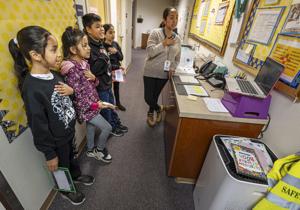Santa Fe Public Schools (SFPS) recently released testing data that reveals both progress and setbacks in student proficiency levels. The results indicate a 2 percentage point increase in reading proficiency, with approximately 42% of students meeting expectations. In contrast, science proficiency saw a decline of 3.5 points, dropping to 32.6%, while math scores remained stagnant at 22%.
District officials expressed optimism about these mixed results, pointing to new curriculum initiatives and programs expected to yield positive outcomes in reading, math, and science. Beata Thorstensen, SFPS chief assessment officer for learning and school improvement, acknowledged the distance still to be covered but affirmed that the district is “headed in the right direction.”
Understanding Proficiency Data
The proficiency data for SFPS is primarily based on student scores from the New Mexico Measures of Student Success & Achievement (NM-MSSA) test for grades three through eight, and the SAT for 11th graders. Students with learning disabilities can opt for the Dynamic Learning Maps test. This year’s changes highlight persistent disparities among schools within the district. Schools in the northeast of Santa Fe generally performed better than those in the south, which tend to serve higher proportions of English learners and students from low-income households.
Among the notable successes, Mandela International Magnet School achieved a remarkable 9-point increase in reading proficiency, leading the district with 83.33% of its students scoring proficient. Similarly, El Dorado Community School reported an 8-point rise, reaching 80% proficiency in reading. Both Acequia Madre and Atalaya Elementary Schools excelled in math, with improvements of 9 and 7 points, respectively, both exceeding 50% proficiency.
Efforts to Improve Instruction
Despite some schools experiencing considerable gains, others continued to struggle. Sweeney Elementary School matched Mandela’s increase with a 9-point rise in reading, reaching 19% proficiency. E.J. Martinez Elementary and Milagro Middle School also bucked trends in math, with gains of 6 and 5 points, lifting their proficiency to 25% and 15%, respectively.
The district’s growth parallels broader trends in New Mexico, as reported by the New Mexico Public Education Department. The department noted overall improvements in reading across the state, with Mariana Padilla, Public Education Secretary, attributing this success to the structured literacy initiative launched in 2020. This program trains educators to effectively support students struggling with reading.
Thorsten shared that nearly all SFPS teachers in grades K-5 are expected to be trained in this approach, with 158 teachers having completed the training and 224 currently in progress. Additionally, 35 sixth-grade teachers are working through a similar training pathway designed for middle school students.
In terms of mathematics, the district is collaborating with the Public Education Department to establish math labs for grades K-2 at seven elementary and K-8 schools, including Atalaya and El Dorado. This initiative will provide targeted interventions for early math learners, ensuring they receive the necessary support.
Science instruction is also undergoing significant changes. SFPS is adopting resources from the nonprofit OpenSciEd, aiming to create a more engaging and practical science curriculum. This approach focuses on inquiry-based learning, encouraging students to conduct experiments and explore scientific concepts through real-world questions.
Despite the challenges, the district is optimistic. Capital High School, for instance, reported a 3-point increase in math proficiency, now at 4.56%. Thorstensen noted that while the starting point was low, the growth represents a meaningful step forward.
Some of the schools receiving enhanced funding for math initiatives are already top performers, including El Dorado Community School and Wood Gormley Elementary. Addressing potential concerns about uneven support, Thorstensen emphasized that new math programs are designed to benefit all schools in the district.
The emphasis on comprehensive training and curriculum innovation reflects SFPS’s commitment to improving educational outcomes. As these initiatives take root, the district hopes to see sustained improvements in student proficiency across all subjects.





































































